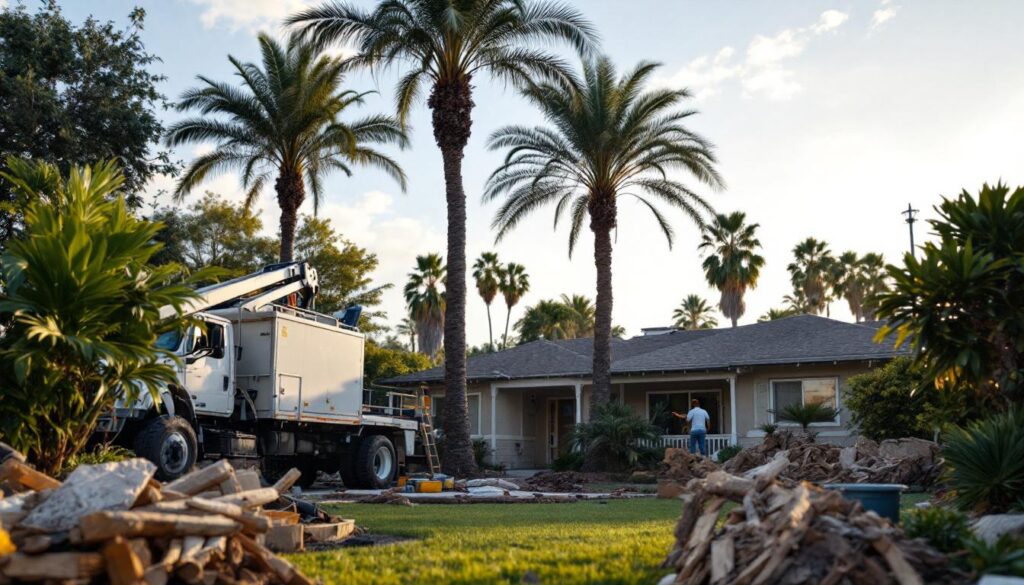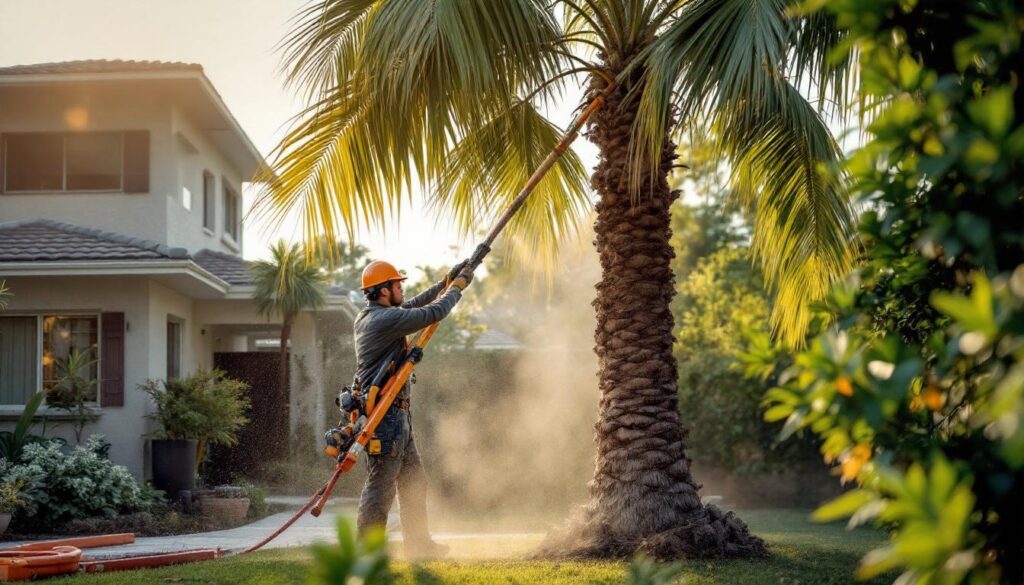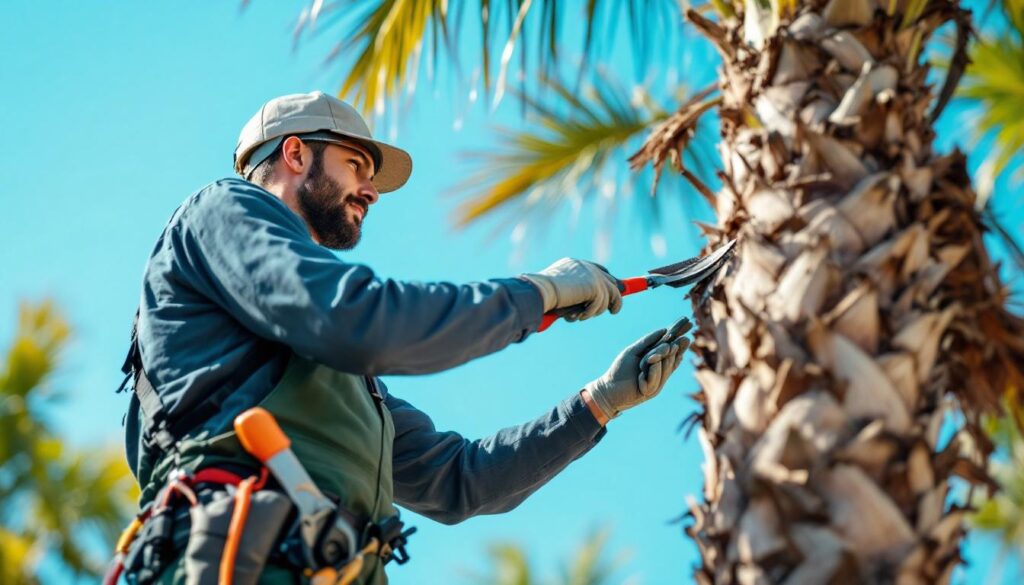What Is Palm Tree Pruning and Why Is It Important?
Palm tree pruning is a specialised form of safe tree maintenance that involves the careful removal of dead, dying, or damaged fronds from palm trees. Unlike regular tree pruning, which can be done with general techniques, palm maintenance requires specific methods that understand how these tropical plants grow.
The importance of proper palm care goes beyond just making them look good. Regular pruning stops dead fronds from piling up, which can become fire hazards or places for pests to breed. You’ll notice that well-kept palms are better at fighting off diseases and staying strong during severe weather events.
Professional palm trimming services bring essential expertise to this delicate process. Certified arborists understand the critical difference between healthy green fronds that should never be removed and brown, yellowing fronds that require attention. They have the knowledge to:
- Identify the best time to prune
- Avoid over-pruning that weakens the tree
- Maintain proper cutting angles for water drainage
- Recognise signs of disease or pest infestation
Safety considerations make professional intervention crucial. Palm trees often grow very tall, creating significant dangers for untrained individuals attempting DIY maintenance near power lines or on unstable surfaces.
What Are the Essential Techniques for Effective Palm Tree Pruning?
Palm tree pruning techniques require precision and knowledge to maintain tree health whilst avoiding common mistakes that can harm your palms. The most critical principle involves selective frond removal – you should only remove fronds that have turned completely brown or yellow. Green fronds actively photosynthesize and provide essential nutrients to the tree, so cutting healthy fronds weakens the palm and makes it susceptible to disease and pest attacks.
When removing dead fronds, create a proper water runoff angle by cutting close to the trunk without damaging the bark. This angled cut prevents water from pooling on the cut surface, which could lead to fungal infections or rot. The cut should slope away from the trunk to encourage natural drainage.
Key pruning techniques include:
- Selective removal: Only cut fronds hanging below a horizontal line from the trunk
- Clean cuts: Use sharp, sterilised tools to prevent disease transmission
- Timing: Prune during dry seasons to reduce infection risks
- Seed removal: Remove flower stalks and seed pods to redirect energy to growth
Proper technique also involves avoiding “hurricane cuts” – the harmful practice of removing all fronds. This extreme pruning stresses the palm and creates an unnatural appearance. Instead, maintain the palm’s natural crown shape by removing only the oldest, lowest fronds whilst preserving the younger, upward-growing ones that contribute to the tree’s vitality.
Why Is Safety a Critical Concern During Palm Tree Pruning?
Palm tree pruning safety presents unique challenges that distinguish it from other tree maintenance activities. Mature palms can reach heights of 15-30 metres, creating significant trimming hazards when workers attempt to access the crown where fronds require removal.
Height-Related Risks
Working at elevation exposes pruners to serious fall injuries. The smooth trunk surface of most palm species offers limited grip points, making ladder placement precarious. You face additional complications when dealing with coconut palms or date palms, where heavy fruit clusters can unexpectedly dislodge during pruning operations.
Electrical Dangers
Electrical dangers pose life-threatening risks when palms grow near power lines. Fronds conduct electricity when wet, and metal pruning tools can create fatal contact points. Sydney’s suburban areas frequently feature palms planted close to overhead cables, requiring extreme caution during any trimming activity.
Professional Safety Measures
Certified arborists employ specialised safety protocols to mitigate these risks:
- Personal Protective Equipment: Hard hats, safety harnesses, and insulated gloves
- Stable Equipment: Professional-grade ladders with stabilising outriggers
- Power Line Protocols: Coordination with utility companies for safe working distances
Training programmes ensure professionals understand proper climbing techniques, equipment inspection procedures, and emergency response protocols. Level 5 certified arborists possess the expertise to assess each palm’s unique safety challenges before beginning work, protecting both workers and property from preventable accidents.
In line with these professional practices, it’s essential to consider the broader aspects of palm tree care beyond just pruning. For instance, understanding the best practices in palm tree management can significantly enhance the overall health and longevity of these plants while ensuring safety during maintenance activities.
What Are the Advantages of Hiring Professional Palm Tree Pruning Services?
Certified arborists bring specialised knowledge that transforms palm tree care from guesswork into precise science. These professionals possess the expertise to identify subtle signs of disease, nutrient deficiencies, and structural weaknesses that untrained eyes often miss. You benefit from their ability to distinguish between healthy green fronds that should remain and yellowing fronds that require removal, ensuring your palms maintain optimal health.
Expert tree care extends beyond basic cutting techniques. Professional services utilise advanced diagnostic tools and cutting-edge equipment designed specifically for palm maintenance. Modern chainsaw technology, hydraulic lifts, and specialised pruning tools enable safe access to towering palms whilst minimising stress on the tree structure.
The professional palm trimming benefits become evident in the long-term health of your landscape. Qualified arborists understand palm biology, applying pruning methods that preserve the natural crown shape whilst promoting robust growth patterns. They create proper angles for water drainage, preventing fungal infections that commonly plague improperly maintained palms.
Professional services maintain detailed records of your palm’s condition, tracking growth patterns and health changes over time. This systematic approach allows for proactive care, addressing potential issues before they become costly problems. You receive personalised maintenance schedules tailored to your specific palm species and local environmental conditions, ensuring each tree receives appropriate care throughout the seasons.
Why Is DIY Palm Tree Trimming Often Risky and Ineffective?
The Risks of DIY Palm Tree Trimming
DIY palm pruning risks present serious dangers that many homeowners underestimate. Falls from ladders remain the most common accident, particularly when working on mature palms that can reach heights of 15-30 metres. You face additional electrical hazards when palms grow near power lines – a single contact can result in electrocution or serious burns.
The Consequences of Improper Trimming
The improper trimming consequences extend beyond immediate physical dangers. Many DIY enthusiasts make the critical mistake of removing healthy green fronds, believing this promotes growth. This practice actually weakens the palm by reducing its ability to photosynthesise and produce essential nutrients. Incorrect cutting angles create water collection points that invite fungal infections and pest infestations.
The Problems Caused by Timing Errors
Timing errors compound these problems significantly. Pruning during the wrong season can stress the palm and make it vulnerable to disease. You might inadvertently remove the palm’s natural defence mechanisms by cutting too aggressively or at inappropriate times.
The Safety Hazards of Lack of Equipment and Training
The safety hazards multiply when you lack proper equipment and training. Professional arborists use specialised climbing gear, safety harnesses, and cutting tools designed specifically for palm maintenance. Without this equipment, you’re essentially gambling with your safety while likely achieving subpar results.
The Time Investment Required for DIY Trimming
Time investment becomes another significant factor. What takes professionals 1-2 hours can consume your entire weekend, often requiring multiple attempts to achieve acceptable results. This inefficiency costs you valuable time whilst potentially compromising both your safety and the palm’s health.

How Do Local Regulations Impact Palm Tree Pruning Practices?
Sydney’s tree pruning permits requirements can catch property owners off guard when planning palm maintenance work. Different Local Government Areas (LGAs) across Sydney maintain specific regulations governing tree pruning activities, particularly for mature palms or those located in heritage conservation areas. You must obtain council approvals before commencing significant pruning work, as failure to secure proper permits can result in substantial fines ranging from hundreds to thousands of dollars.
Certified arborists serve as invaluable guides through Sydney’s complex regulatory landscape. These professionals understand the intricate requirements of each council area and can prepare the necessary documentation on your behalf. They assess whether your palm pruning project requires development applications, tree preservation orders, or simple notification processes. Experienced arborists like those at Arbor Pride possess deep knowledge of local regulations compliance across Sydney’s North Shore, Hills District, and surrounding regions.
The paperwork process involves detailed assessments, photographic evidence, and technical reports that demonstrate the pruning necessity. Professional arborists streamline this bureaucratic maze by:
- Identifying specific permit requirements for your location
- Preparing comprehensive application documentation
- Liaising directly with council officers
- Ensuring all safety and environmental standards are met
Council approvals protect both property owners and the urban canopy. Non-compliance can lead to stop-work orders, hefty penalties, and potential legal action. Professional arborists eliminate these risks by maintaining current knowledge of evolving regulations and established relationships with local councils.
What Safety Tips Should Be Followed When Performing Palm Tree Pruning?
Palm tree pruning safety tips form the foundation of any successful trimming operation. You need comprehensive protective gear use to shield yourself from falling debris, sharp fronds, and potential cuts during the pruning process.
Essential Personal Protective Equipment
Your safety equipment checklist should include:
- Hard hat or helmet – protects against falling fronds and coconuts
- Safety glasses – shields eyes from dust and debris
- Cut-resistant gloves – prevents hand injuries from sharp palm fronds
- Steel-toed boots – protects feet from falling materials
- Long-sleeved shirts – guards against cuts and scrapes
Ladder Stability and Positioning Guidelines
You must establish a stable base before ascending any ladder. Position your ladder on level ground and maintain the proper 4:1 ratio – for every four feet of ladder height, the base should be one foot away from the palm trunk. Never place ladders near power lines, maintaining at least three metres clearance from electrical hazards.
Storm Season Preparation
Preparing trees before storm seasons requires strategic timing and technique. You should remove dead, damaged, or loose fronds that could become projectiles during high winds. However, avoid over-pruning green fronds, as palms need their full canopy to withstand storm forces effectively.
Professional arborists recommend scheduling palm maintenance during Sydney’s dry months, allowing trees to recover before the next storm season arrives.
How Does Professional Palm Tree Pruning Contribute to Long-Term Landscape Health?
Professional palm tree pruning is essential for maintaining long-term tree health across Sydney’s diverse landscapes. When certified arborists remove diseased, damaged, or dying fronds at the right time, they stop harmful pathogens from spreading throughout the tree’s vascular system. This targeted approach prevents infections before they weaken the palm’s structure and overall vitality.
The Aesthetic Benefits of Professional Pruning
The aesthetic improvement palms receive through professional care goes beyond just looks. Expert pruning keeps each palm’s natural growth pattern and unique shape intact, ensuring your landscape maintains its intended design vision. Professional arborists know how to strike a balance between removing problematic fronds and preserving the tree’s natural beauty, avoiding the common mistake of over-pruning that can make palms look artificially shaped.
The Long-Term Advantages of Landscape Maintenance
Landscape maintenance benefits multiply over time when you choose professional pruning services. Well-maintained palms develop stronger root systems and more resilient trunk structures, providing a stable base for years of healthy growth. This proactive approach greatly reduces the chances of:
- Sudden limb failure during severe weather events
- Property damage from falling fronds or debris
- Emergency removal costs due to neglected tree health issues
- Pest infestations that can spread to nearby plants
Moreover, it’s important to consider that these landscape maintenance benefits also influence your overall landscaping costs. Regular professional upkeep turns your palms into long-term landscape assets instead of potential liabilities, safeguarding both your property investment and the surrounding ecosystem.

What Qualifications and Certifications Should You Look for in a Palm Tree Pruning Service?
Choosing the right qualifications and certifications for your palm tree pruning service ensures that your trees receive expert care while also protecting your investment in the property. Here are some key qualifications and certifications to look for:
1. Certified Arborists
Prioritise professionals who hold International Society of Arboriculture (ISA) membership and Level 2-5 tree practitioner certifications. These credentials demonstrate comprehensive training in proper pruning techniques and tree health assessment.
2. ISO Certifications
ISO certifications can provide additional assurance of quality for tree care providers. Look for companies certified under ISO 14001, 4801, and 9001, which guarantee environmental responsibility, workplace safety, and consistent service delivery standards.
3. Experience with Local Regulations
Experience with Sydney’s unique regulations is invaluable when navigating council requirements and permit applications. Local arborists have a deep understanding of specific council guidelines across different Local Government Areas (LGAs), which helps prevent costly compliance issues and project delays.
4. Insured Services
Ensure that the tree services you hire have substantial public liability coverage—ideally $20 million. This insurance protects you from potential accidents or property damage that may occur during pruning operations, demonstrating the company’s commitment to professional standards.
5. Membership with Professional Bodies
Verify whether the professionals you are considering are members of industry bodies such as Arboriculture Australia and the Tree Contractors Association. These organisations maintain industry standards and require ongoing education for their members, ensuring that they stay updated with best practices in arboriculture.

